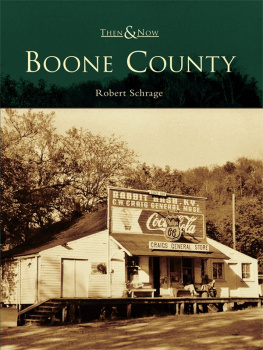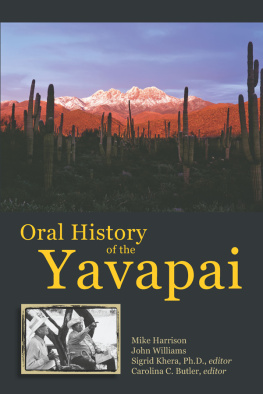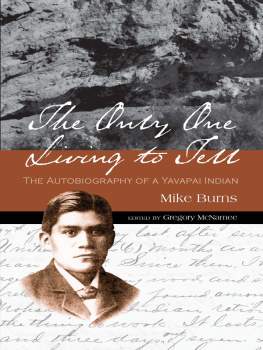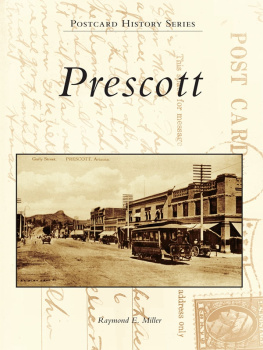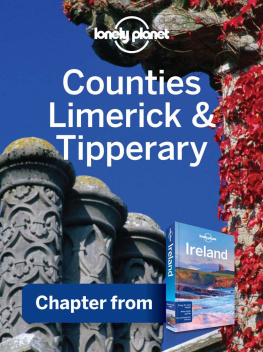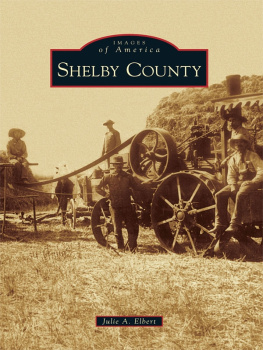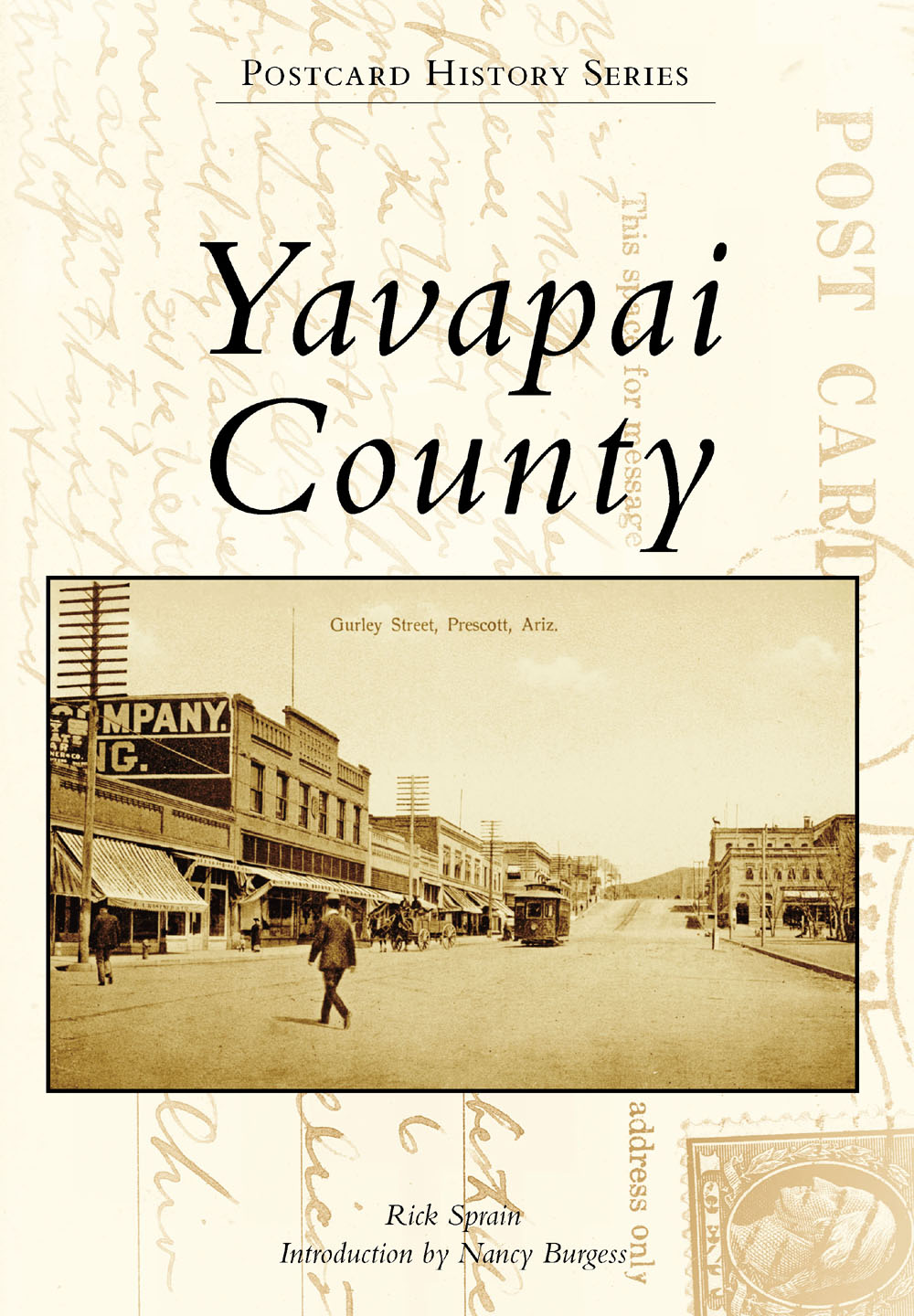
POSTCARD HISTORY SERIES
Yavapai
County
ON THE FRONT COVER: PRESCOTT, GURLEY STREET, C. 1910 (HAND COLORED POSTCARD). This street was named after John A. Gurley, who would have been the first territorial governor of Arizona if he had not died before taking office in August 1863. Gurley was a Republican US congressman from Ohio from 1856 to 1863. President Lincoln named Gurley territorial governor of Arizona but after his death replaced him with John N. Goodwin. (Published by M. Reider Publ., authors collection.)
ON THE BACK COVER: JEROME, UNITED VERDE WORKS, C. 1910 (HAND COLORED POSTCARD). After a new smelter was constructed in Clarkdale, the smelter seen here was removed to make way for an open pit mine. At the United Verde Pit, some ore was as much as 40 percent copper, and silver was more than 200 ounces per ton. (Published by E.W. Carroll, courtesy John Taylor.)
Postcard History Series
Yavapai
County
Rick Sprain
Introduction by Nancy Burgess

Copyright 2016 by Rick Sprain
ISBN 978-1-4671-2450-8
Ebook ISBN 9781439659052
Published by Arcadia Publishing
Charleston, South Carolina
Library of Congress Control Number: 2016942231
For all general information contact Arcadia Publishing at:
Telephone 843-853-2070
Fax 843-853-0044
E-mail
For customer service and orders:
Toll-Free 1-888-313-2665
Visit us on the Internet at www.arcadiapublishing.com
To my wife Nicole, who has stood by me unquestionably as I took on this seemingly endless adventure
CONTENTS
ACKNOWLEDGMENTS
I never would have completed this book without the help of local historians, historical societies, friends, and most of all, other postcard collectors who have a passion to collect and share their cards. I would first like to thank Kelly Graham and the Skull Valley Historical Association. Kelly was one of the first people I spoke with, and his enthusiasm was infectious. He allowed me access to the collections at the Skull Valley Archives, and he was instrumental in introducing me to others in Yavapai County who were more than willing to assist me. John Taylor, who has one of the best mining postcard collections out there, took his own time and scanned dozens of old cards out of his collection for this book. Both Andrew Christenson, curator, and Cynthia Gresser, executive director of the Smoki Museum, allowed me to scan the postcards in the museums collection. Also, Andrew, who has a wonderful collection of local cards, allowed me to use his personal collection for the book. Bagdads Bob Delgado single-handedly saved the towns and mines histories and started the towns museum and archives. Tony Meager opened up his spectacular personal collect of Arizona postcards for me. We spent hours going through his cards and scanning a good chunk of his Yavapai collection. I would also like to thank John Bradshaw. John was kind enough to give me access to his father Bob Bradshaws massive postcard file. Lastly, Id really like to thank Nancy Burgess. She allowed me to go through her personal collection of cards in so many volumes that I lost count. With her vast knowledge of Yavapai County history and her own passion for postcards, Nancy was the only person who I wanted to write the introduction for this book.
All images in this book are from my personal collection unless otherwise noted.
INTRODUCTION
If you are about to start reading Yavapai County, you are most likely interested in one or all of the following: Yavapai County history; images of Yavapai County; images of a particular place; or postcards in general. Almost anyone who picks up a copy of Yavapai County has probably at some point in time purchased, sent, or received a postcard.
It was not until May 1893 at the Columbian Exposition in Chicago that the first souvenir postcards were seen. These chromolithographed images were printed on the backs of US postal penny cards and could be mailed at the 2 letter rate. The government made a penny on the sale of each one. They were packaged in sets and were enormously popular, partly due to the fact that they were in color. Many were taken home and saved and were never mailed. The people who purchased these were the first postcard collectors.
Collecting postcards was a popular way for those who traveled to create albums of their visits around the world or across the country or even to the big city in their own home state. Special postcard albums were marketed, encouraging the purchasing, sending, and receiving of postcards. Today, deltiology (the collection of postcards) is the third most popular collecting hobby in the world, surpassed only by the collection of coins and stamps.
Each postcard tells a part or all of a small story. Not only is the image interesting to collectors and historians, but the message, the stamp box, the information printed by the publisher, and the printing technique used for the postcard are also of interest. If the card was used and mailed, the stamp and postmark and the names of the addressee and the writer, if present, are also of interest. Taken together, all of these small pieces of information tell a story about a time and a place.
As the concept of the souvenir postcard caught on, photographers from all over the world sent their images to large companies which specialized in printing postcards. Prior to World War I, millions of color lithograph postcards were printed in Germany, which mastered the art of postcard printing, sometimes using up to 40 colors in the printing process. These cards were manufactured during what is called the golden age of postcards. After World War I, companies such as Albertype and Curteich-Chicago C.T. Art-Colortone produced thousands of domestic postcards for the ever-growing souvenir and advertising postcard markets.
Locally, itinerant photographers would travel through communities and neighborhoods or set up outdoor studios, taking portraits of the family on the front porch, the children in a wagon or on a pony or the cowboy on his horse. Many of these images were printed as Real Photo Postcards (RPPCs) and delivered to the subjects of the photograph on the same or the next day.
For many, the Wild West of the late 19th and the first half of the 20th century was a mystery. The introduction of Arizona postcards gave newcomers and visitors the opportunity to tell the folks back home what Arizona was really like, and the cities and towns of Yavapai County were soon represented by the picture postcard. At the same time, regional and local communities were realizing that postcards were a cheap and easy way to advertise their businesses, economic development opportunities, recreation, transportation routes, and historic and scenic attractions.
Since the beginning of the 20th century, postcard collectors have sought out the beautiful scenes of Arizona, but only recently have collectors sought out postcards as a historic record offering a treasure trove of images and comments. The first scenic views of Arizona were published starting about 1900 by commercial publishers in the eastern United States. The cards were often lovely, hand-colored views of the Grand Canyon and other now well-known scenes. Also, about 1900, local photographers began producing more specialized postcards that focused on the important buildings, events, and places of their communities. These are a treasure for todays collectors.
Postcards have provided a way for cities and towns to recapture their history through photographs. The photographic and physical history of a place can often be reconstructed almost exclusively through postcards. Many of the best photographs produced by professional or semi-professional photographers were printed as postcards, either through a major publishing company or locally. In
Next page

